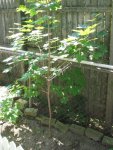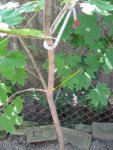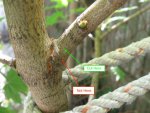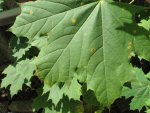Hi Everyone!
I hope your day is going well & includes fun!
About ten years ago, way in the back of my yard, I planted a seed from a nearby Norway Maple. It's grown nicely. I would like to transplant it to a place of respect when the weather & season are right.
But, I have a curiosity about the spot where the trunk branches into two main branches. I think it is called the 'crotch' of the tree.
Does this joint move up as the tree grows? (Not that I'm young enough to be around to find out) I sometimes read that trees only grow from the top, and such joints stay where they are- about 2 feet from the earth in this case.
Some photos are attached to hopefully fill in where my words fail to communicate.
Thanks for explaining this. It'll fun to watch the tree grow as the years pass.
Enjoy Today!
Paul
I hope your day is going well & includes fun!
About ten years ago, way in the back of my yard, I planted a seed from a nearby Norway Maple. It's grown nicely. I would like to transplant it to a place of respect when the weather & season are right.
But, I have a curiosity about the spot where the trunk branches into two main branches. I think it is called the 'crotch' of the tree.
Does this joint move up as the tree grows? (Not that I'm young enough to be around to find out) I sometimes read that trees only grow from the top, and such joints stay where they are- about 2 feet from the earth in this case.
Some photos are attached to hopefully fill in where my words fail to communicate.
Thanks for explaining this. It'll fun to watch the tree grow as the years pass.
Enjoy Today!
Paul





